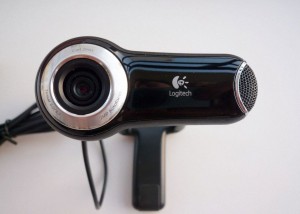How does Linux detect your webcam?
来源:互联网 发布:昆仑虚麒麟臂升阶数据 编辑:程序博客网 时间:2024/06/04 23:25
本文转载至:http://www.netinstructions.com/automating-picture-capture-using-webcams-on-linuxubuntu/
Well if it's a USB webcam, plug it in. If it's an integrated webcam built into the laptop, there's nothing to plug in. Ubuntu should automatically detect and install drivers for the webcam. To see if it's detected, let's run some commands:
Here's a command to see if any video device nodes exist:
stephen@ubuntu:~$ ls -l /dev/video* crw-rw----+ 1 root video 81, 0 Mar 18 20:29 /dev/video0 crw-rw----+ 1 root video 81, 1 Apr 2 08:03 /dev/video1
And here's another command to find out about the devices:
stephen@ubuntu:~$ lsusb Bus 001 Device 003: ID 046d:0990 Logitech, Inc. QuickCam Pro 9000 Bus 001 Device 002: ID 13d3:5111 IMC Networks Integrated Webcam Bus 004 Device 002: ID 0b05:1788 ASUSTek Computer, Inc. Bus 001 Device 001: ID 1d6b:0002 Linux Foundation 2.0 root hub Bus 002 Device 001: ID 1d6b:0002 Linux Foundation 2.0 root hub Bus 003 Device 001: ID 1d6b:0001 Linux Foundation 1.1 root hub Bus 004 Device 001: ID 1d6b:0001 Linux Foundation 1.1 root hub
More information on lsusb can be found by reading the lsusb 'man page' (otherwise known as the manual). You can also use the lsusb command to learn more about the resolution of the webcams. Just change the Bus and Device numbers that you found above.
stephen@ubuntu:~$ lsusb -s 001:002 -v | egrep "Width|Height" wWidth 640 wHeight 480 wWidth 800 wHeight 600 wWidth 1024 wHeight 768 wWidth 1280 wHeight 720If for some reason you plug in the webcam but it doesn't show up (in
/dev/video* or lsusb), try looking at the recent driver messages for clues:stephen@ubuntu:~$ dmesg|tailfswebcam, ffmpeg, MPlayer, and VLC
There are a few command line tools that will let you take a picture using your webcam. I've tried three different tools and found that I liked fswebcam the most, but I've listed all of the options here:
Note that you might need to change your device from /dev/video0 to perhaps /dev/video1! Check the above section to see what webcam is detected.
ffmpeg
ffmpeg -f video4linux2 -i /dev/video0 -vframes 1 test.jpg ffmpeg -f video4linux2 -s 640x480 -i /dev/video1 -vframes 1 /home/stephen/webcamphotos/$(date +\%Y\%m\%d\%H\%M).jpg
- ffmpeg man page
- ffmpeg documentation
fswebcam
fswebcam -d /dev/video0 -r 640x480 --jpeg 85 -F 5 test.jpgThis uses a compression factor of 85 (good tradeoff of quality/size) and captures 5 frames (for less noise in image).
- fswebcam man page
MPlayer
mplayer tv:// -tv driver=v4l2:device=/dev/video0:width=640:height=480 -frames 3 -vo jpeg
- MPlayer documentation
- archLinux article on MPlayer
VLC
vlc -I dummy v4l2:///dev/video0 --video-filter scene --no-audio --scene-path /home/stoppal/test --scene-prefix image_prefix --scene-format png vlc://quit --run-time=1
Some notes about the Logitech Quickcam Pro 9000

If you are using the Logitech Quickcam Pro 9000 it has an advertised maximum resolution of 1600x1200. Let's try to run that with fswebcam.
stephen@ubuntu:~$ fswebcam -d /dev/video1 -r 1600x1200 --jpeg 85 -F 5 /home/stephen/webcamphotos/$(date +\%Y\%m\%d\%H\%M).jpeg--- Opening /dev/video1...Trying source module v4l2.../dev/video1 opened.No input was specified, using the first.Adjusting resolution from 1600x1200 to 960x720.--- Capturing 5 frames...Captured 5 frames in 0.40 seconds. (12 fps)--- Processing captured image...Setting output format to JPEG, quality 85Writing JPEG image to ~/home/stephen/webcamphotos/201304051633.jpeg.Wait a second! Why did it adjust the resolution to 960x720?
It turns out we need to force it to use a YUYV palette instead of the default
stephen@ubuntu:~$ fswebcam -d /dev/video1 -p YUYV -r 1600x1200 --jpeg 85 -F 5 /home/stephen/webcamphotos/$(date +\%Y\%m\%d\%H\%M).jpeg
Configure crontab (make a cronjob) to take a picture every minute or hour
Crontab is a popular *nix utility that executes a command on a user defined interval. Maybe you just want to take a picture every minute, or maybe you want to shutdown your computer Monday through Friday at 10pm. Or maybe you want to run some scripts that backup your data once every 3 months. If you want to run multiple commands you can do so by chaining them with the && keyword, but it's also sometimes worth making a bash script (or maybe a simple Python/Perl/Ruby script) that gets executed as part of the cronjob.
To view the current cron jobs for the current user, type crontab -e. To view the current cron jobs for the super user, type sudo crontab -e.
Here are some cronjobs I have set up:
# To take a picture every minute # */1 * * * * streamer -f jpeg -s 1024x768 -o /home/stephen/timelap/$(date +\%m\%d\%k\%M).jpeg# To take a picture every hour on the 15 minute mark using a different tool# 15 * * * * fswebcam -r 1024x768 --jpeg 85 -D 4 -F 10 /home/stephen/webcamphotos/$(date +\%Y\%m\%d\%k\%M).jpeg# Take a picture and upload it to the webserver every hour@hourly bash /home/stephen/scripts/take_photo_and_push.sh
The last cronjob calls a bash script that looks like this:
#!/bin/bash #Take a picture, then push it to a remote webserver#Take a photofswebcam -d /dev/video1 -p YUYV -r 1600x1200 --jpeg 85 -D 2 -F 15 /home/stephen/webcamphotos/$(date +\%Y\%m\%d\%H\%M).jpeg#Navigate to the directorycd /home/stephen/webcamphotos/#Find the most recent jpegNEW_JPEG=$(ls -t | grep '\>.jpeg' | head -1)#Push it to the remote webserverscp /home/stephen/webcamphotos/$NEW_JPEG stephen@netinstructions.com:/home/stephen/netinstructions.com/homeserver/latest.jpeg
For more information on cronjobs and crontab, take a look at this guide.
If you want to view any logs for the the cron job you can view the logs by typing:
$ grep CRON /var/log/syslogViewing/Transferring the Pictures
Okay, so you found a command line utility that takes pictures, and perhaps a cronjob that runs that command every 5 minutes or 10 minutes or every hour or once a day, but how do you look at the picture?
There are a couple of ways of doing this. If you're using the desktop version of Ubuntu (with a nice graphical user interface) you just double click on the photo. For the rest of us who are SSH'ing in to a remote machine or are using the server version of Ubuntu or some other Linx distro, we have a few options:
- FileZilla to grab the files and transfer them to our local machines
- If you have a web server (Apache, ngnix, or something else) on the server, move the file to the web directory
- SCP the file to a remote web server. For example, I have a few websites (such as this one) hosted by Dreamhost, and they provide shell access
The command to securely transfer a file on one machine to another looks like this:
scp /home/stephen/webcamphotos/$NEW_JPEG stephen@netinstructions.com:/home/stephen/netinstructions.com/homeserver/latest.jpegGood luck!
- How does Linux detect your webcam?
- how does eclipse optimize your android code
- Probe how does your PGA consume
- Joel test : how much does your company get?
- How Much Bandwidth Does Your Website Really Need
- HTML5test - How well does your browser support HTML5?
- How Does The Linux File System Work?
- How to Backup Your System in linux
- How to Cast Your Android Screen onto Your Linux Desktop
- Testing your USB Webcam开摄像头
- how detect Interbase/FireBird Running
- How does your app utilize File Sharing feature?(iOS 支持文件共享UIFileSharingEnabled)
- Android Studio does not detect .aidl files
- Does your mother know
- webcam
- Linux hung task detect
- How to customize a link at your desktop in LINUX
- How to Change Timezone in your Linux System
- linux下实现服务器与客户端(连接时给客户端发送时间)
- Java Lambda表达式初探
- [BZOJ3530][Sdoi2014]数数(AC自动机+数位dp)
- Nginx函数ngx_single_process_cycle学习笔记
- [牛客网]二叉树的镜像
- How does Linux detect your webcam?
- Java集合框架源码剖析:LinkedHashSet 和 LinkedHashMap
- 安装maven
- 支持优先队列操作的TreeSet
- 剑指offer-面试题29-数组中出现次数超过一半的数字
- B. Restoring Painting
- Python轻松入门-01Python的安装
- 复习C语言———《C Prime Plus(第六版)》 第13章~第17章
- 阿里云RDS数据本地恢复


